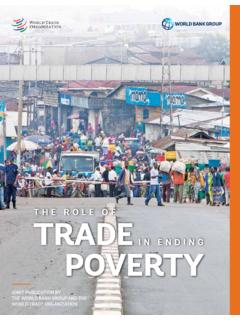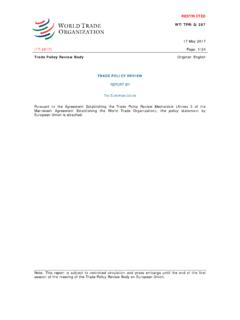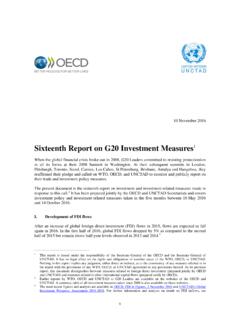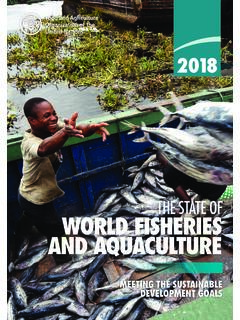Transcription of C ThE ECONOMiCS OF SUBSiDiES - World Trade Organization
1 Ii SUBSiDiES , Trade AND ThE WTOC tHe ECONOMiCS of SUBSIdIeSworld Trade report 200655C ThE ECONOMiCS OF SUBSiD iES1. iNTRODUCTiONthe purpose of this Section is to assist the reader to better understand the twin questions of why governments use SUBSiDiES and how SUBSiDiES impact international Trade . as is frequently the case in economic analysis, the starting point for what follows is a benchmark economy featuring perfectly competitive this approach provides the basis for general insights into the impact of policy interventions such as SUBSiDiES . as discussed further below, under the condition of a perfectly competitive market, no case can be made for a subsidy. Introducing a subsidy or some other government measure within a perfect market framework will be inefficient and welfare-diminishing. But if the perfect market assumption is relaxed, situations may arise where a government measure like a subsidy improves welfare.
2 An efficient subsidy would correct a market failure, bringing social and private costs and benefits into alignment. Neither in this Section nor elsewhere in this report have we undertaken a systematic analysis of how SUBSiDiES compare with other policy interventions that might be used to achieve similar objectives. references to this question are, however, made in several places in the report, notably in Section d dealing with objectives. It may nevertheless be useful to mention here that the choice of policy instrument to attain a particular objective can be important from an efficiency standpoint. this can be illustrated by a simple example. Suppose that a government decided to protect a particular domestic industry on the grounds that there were learning-by-doing effects associated with the activity from which the wider economy would benefit, and that these benefits were not properly reflected by the market.
3 In this case, a government might choose between imposing a tariff on competing imports or directly subsidizing the industry concerned. a tariff would raise the domestic price of imports and allow the protected industry s output price to rise to the same level. domestic consumers would then have to pay the higher price. But if a subsidy were used, the domestic price would still be the duty-free import price, and the subsidy received by the domestic industry would allow it to compete with imports at World prices. Consumers would not be taxed, and the subsidy option would be regarded as the more efficient one. this is an application of the theory of optimal intervention (Johnson, 1965; Bhagwati 1971). one issue that is not dealt with in the above example is the costs associated with financing and distributing a subsidy. It is assumed that this can be done costlessly, which will not be the case.
4 Economic costs will still be incurred, even if taxes are levied in a non-distorting manner. Moreover, developing countries in particular may face difficult administrative hurdles in collecting revenue to be disbursed as SUBSiDiES . Similarly, identifying recipients of SUBSiDiES and implementing subsidy programmes are also not without their costs. taken together, however, if the assumption of zero-cost subsidy collection and disbursement is removed, it will not affect the key arguments that are put forth in this Section. a final point to be made here relevant both to this Section and other parts of this report concerns a key distinction in terms of the incidence of two types of SUBSiDiES export SUBSiDiES and production SUBSiDiES . export SUBSiDiES are contingent upon exports only and will have different resource allocation and efficiency implications than production SUBSiDiES .
5 Production SUBSiDiES apply to output regardless of its market destination, but they can also affect rest of this Section is organized as follows. we shall first examine the welfare implications of SUBSiDiES in a World of perfect markets, a World in which SUBSiDiES can never be justified in terms of economic welfare. we shall then introduce a range of market imperfections or failures that correspond more to reality and see if this modifies the welfare analytics of subsidization. the market failures we consider are economies of scale and externalities. finally, we shall examine a number of additional considerations that may influence subsidy 30 perfectly competitive markets exist with costless and free entry and exit by firms, homogenous products, constant returns to scale, the absence of any possibility for individual producers or consumers to affect prices, and the possession of full information on the part of consumers and producers.
6 In practice, of course, these conditions rarely, if ever, exist. ii SUBSiDiES , Trade AND ThE WTOC tHe ECONOMiCS of SUBSIdIeSworld Trade report 200656outcomes, in particular challenges facing policymakers in actually implementing sound subsidy policy, and the influence of political economy factors on subsidy decisions. 2. PERFECT MARKETSIf a market is assumed to be perfect and closed to international Trade , production SUBSiDiES to firms have the effect of expanding output, reducing the price paid by consumers and creating an overall welfare loss, since resources will be allocated inefficiently. Introducing international Trade into this scenario complicates matters. for example, an important distinction is whether the subsidy is granted to an import competing or export competing industry. If it is the former and assuming World prices are unaffected,31 the end result will be an expansion in domestic output at the expense of imports (Box 2).
7 A welfare loss arises from the application of the subsidy, since the subsidy creates a wedge between the optimal price ( World price) and the actual price paid to domestic Since the country is assumed to be small, the domestic price is fixed by the World price and cannot 2: Trade effects of production subsidiesIn the diagram below domestic supply is given by S0, domestic demand by d0 and World price of the product is given by p*. Since the World price is below the price that would clear the domestic market, the total quantity demanded of the product oQd would be satisfied by oQ0 units of domestic production and Q0Qd of the government, for political or redistributive reasons, decides that the level of domestic production should be oQ1 instead of oQ0, it has to then decide whether or not to use a tariff or a subsidy to expand production.
8 If it uses a subsidy, and assuming it cannot affect World price, domestic supply will shift from S0 to S1 causing domestic production to expand to the desired level and imports to fall by to the subsidy, domestic output was at point Q0. Since additional domestic output beyond that level would cost less to source from the World market, the government will have achieved the desired level of output, but the resource implications for the economy will be negative. the additional cost to the economy is represented by the area *P1Q0Q1 QdOabcS0S1 QuantityPriceD0 Per unitsubsidyii SUBSiDiES , Trade AND ThE WTOC tHe ECONOMiCS of SUBSIdIeSworld Trade report 200657 Now consider the case of an export subsidy to an industry. Both production and export SUBSiDiES may have the effect of expanding domestic output and exports. they differ, however, in their effects on domestic prices.
9 Domestic prices are unaffected by producer SUBSiDiES but rise in the case of export SUBSiDiES if re-imports are prevented. Costs to the taxpayer in the export subsidy case will also be lower than in the production subsidy scenario since the volume of subsidised domestic consumption will be the small country assumption, therefore, the key international Trade insight is that quantities adjust in response to the subsidy intervention. In the domestic production subsidy case, imports contract or exports expand, whereas in the export subsidy case exports expand. Inefficiencies arise in both cases since a portion of domestic output is determined by the subsidy-inclusive price, as opposed to the World the two cases considered above, the subsidizing country was assumed to be a price-taker in the World economy.
10 This means that economic changes within the country will not have any impact on World prices. If this assumption is relaxed, output will still increase as in the small economy case described above. this time, however, the disequilibrium caused by the SUBSiDiES will also cause price effects in international markets. If more output is exported as a result of an export subsidy, then World prices will fall. domestic prices, however, will rise, since some of the output will still have to be sold domestically and there is less quantity available in the market. this point is illustrated in Box this occurs because domestic prices rise with the export subsidy, causing quantity demanded to fall. Box 3: Export subsidy in a large country casean export subsidy creates an incentive for producers to supply for export as opposed to domestic consumption.












